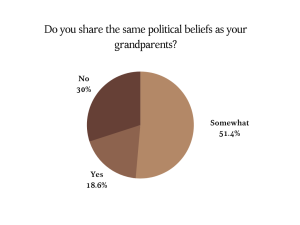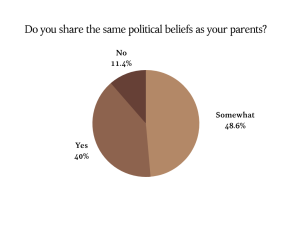Politics
April 5, 2023
The cliche bears some truth: you sit down at your Thanksgiving dinner table and by the time you stand up again you’ve received another harangue about “politics today,” usually from an older family member.
When students were asked to expand on their experiences with generational differences, many explained such divergences are made apparent “when watching the news,” “during the presidential election,” “talking about politics at home,” and when “grandparents started to say things about politics during dinner.”

The political ideologies of different generations represent a larger movement for younger generations to follow more liberal views while shifting away from more conservative views, a trend that has been occurring for at least the past 20 years according to Nick Neauchamp, a professor at Northeastern University.
“I think one of the things that contributes to this is that adolescents, in terms of their thinking, will often experience… adolescence idealism. And it is this notion that as you are figuring out your identity and figuring out where you fit in the world you often pick up different causes and stand behind those. You are often very idealistic in your approach to handling rather complex situations. I think it is part of the cognitive development of adolescents,” said Orlando.

According to the Pew Research Center, most Millennials follow consistently or mostly liberal views. In comparison, the Silent Generation is the only generation where conservative views outweigh liberal views. As the two ideologies pull in opposite directions, not only is political polarization exacerbated but the divide between different generations as a whole widens, maybe so far that individuals can’t even see the other side.
“Access to media makes a difference. I think today more than ever you are able to gear your exposure to whatever your belief is. And there are algorithms that do that for you. If I’m more liberal in my beliefs and I’m scrolling through Twitter and TikTok and Facebook and those platforms, they are going to gear my exposure to go along with those interests that I have. In general, there is a split because now you don’t have to see both sides of the story… It is almost like confirmation bias. You are only looking for the stuff that confirms your belief,” said Orlando.
In today’s Congress, older generations of Generation X, Baby Boomers, and the Silent Generation still make up the majority of seats, making up approximately 35.3%, 48.8%, and 5.4% respectively. However, in recent years, the proportion of Millennial lawmakers in Congress has grown, from making up just 1% of the House in 2017 to 12% in 2023. Now, with Gen Z being eligible to run for Congress and the first Gen Z member of Congress, Maxwell Frost, elected in the November midterm elections, politics is becoming more generationally diverse. Perhaps with this increasing representation in government, more people will come to respect and compromise with the different political views of other generations.